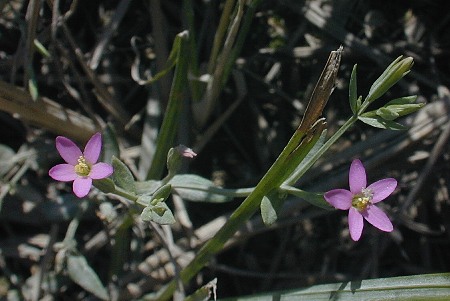Description: This plant is an annual about 3-8" tall that branches occasionally, and it is more or less erect. The stems, leaves, and calyx of the flowers are greyish green and hairless. The slender stems are irregularly angular. The opposite leaves are up to 1" long and ¾" across, becoming smaller as they ascend the stems. They are variably shaped, smooth along the margins, and sessile or slightly clasping the stems. The lower leaves are ovoid or ovate with blunt tips, while the upper leaves are often lanceolate or oblong. Their texture is slightly fleshy and succulent. There is no tuft of basal leaves at the base of the plant. The upper stems terminate in small cymes or flat-headed panicles of flowers; some cymes of flowers may be produced from the axils of the upper leaves as well. Each flower has a narrow tubular corolla that is about ½" long; at its apex, this corolla divides into 5 spreading lobes up to ¼" across. These petal-like lobes are narrow and pink. At the base of the flower, there is a tubular calyx with 5 lobes that are very narrow and long. These calyx lobes are appressed against the base of the tubular corolla and at least half its length (sometimes they are nearly as long as the corolla). At the narrow throat of the flower, there are several exserted stamens with yellow anthers. Each flower has a short pedicel at least 1/8" long. The blooming period occurs during the summer and early fall and lasts about 2-3 months. As older flowers begin to fade away, the area that is enclosed by the lobes of their calyxes begins to swell until ovoid seed capsules are formed. Each seed capsule is open at the top and has 5 recurved teeth along its upper rim. Each of these capsules contains several tiny seeds that can be blown about by the wind or float on water. The root system consists of shallow fibrous roots. This plant spreads by reseeding itself.

Cultivation:
Typical
growing conditions are full sun and a moist soil that contains loam,
clay-loam, or gravelly material. A limy soil and occasional flooding
are tolerated.
Range & Habitat:
Branching Centaury is an uncommon plant that is originally from Europe.
It occurs primarily in a few counties in NE Illinois and does not
appear to be spreading (see Distribution
Map). The webmaster recently found a small colony of plants
growing in Champaign County, Illinois. Habitats include moist
depressions in grassy areas along roads and railroads. So far, this
species is restricted to highly disturbed habitats.
Faunal Associations:
Little information about floral-faunal relationships is available for
this species. The structure of the flowers suggests that long-tongued
bees, small butterflies, and skippers occasionally pollinate the
flowers. One likely candidate is the butterfly Pieris rapae
(Cabbage White), which is originally from Europe. The foliage of plants
in the Gentian family is usually bitter and unattractive to most
herbivores, although rabbits may nibble on the stems and leaves of
Branching Centaury occasionally. The seeds are too small to be of much
interest to birds.

Photographic
Location:
A moist grassy depression that was located a short distance away from a
railroad in Urbana, Illinois. This area was mowed irregularly and prone
to temporary flooding.
Comments:
Branching Centaury is a small plant with delicate pink flowers. It has
many characteristics in common with members of the Pink family
(Caryophyllaceae), but it differs in having a calyx with long slender
lobes that are at least half the length of the tubular corolla.
According to official records, this is the only Centaurium sp.
that has naturalized in Illinois. Some south-central and southwestern
states have native Centaurium spp., but none of
them have been observed in Illinois. These native species tend to have
somewhat larger flowers and more narrow lower leaves. A closely related
species from Europe, the biennial Centaurium erythraea
(Forking Centaury), has been observed in Indiana and may occur
somewhere in Illinois. The inflorescence of this latter species is less
flat-headed and more vertical, while its flowers have shorter calyx
lobes and slightly longer corolla lobes. The Centaurium spp.
differ from the closely related Sabatia spp. (Rose
Pinks) by having smaller flowers that are longer than they are across;
they are always narrowly tubular at the base. The flowers of Rose Pinks
have more open corollas with larger petal-like lobes, while the lobes
of their calyxes are more spreading.